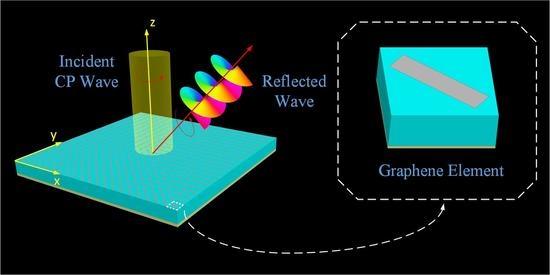Control of the Spin Angular Momentum and Orbital Angular Momentum of a Reflected Wave by Multifunctional Graphene Metasurfaces
Abstract
:1. Introduction
2. Unit Structure Design, Theory, and Simulation
2.1. The Characteristics of Graphene
2.2. The Design and Simulation Response of the Graphene-Based Unit Cell
3. Design Strategy
- (1)
- Firstly, the operation frequency band and the characteristics of the graphene should be considered. The conductivity of graphene includes two parts, i.e., the intra-band part and the inter-band part, and the influence of these on graphene is different in the low-frequency band and the high-frequency band. In our design, a low-frequency band (1.36–1.62 THz) is chosen; therefore, the conductivity of graphene is only determined by the intra-band part. By using Equation (1), a complex conductivity can be obtained.
- (2)
- Secondly, a unit cell composed of the graphene strip and a quartz substrate backed with a metal ground should be modeled in the HFSS software. In the simulation environment, a strip with an impedance boundary condition is adopted to represent the graphene strip. Due to the fact that the graphene’s impedance can be expressed by its conductivity, i.e., , the graphene can be accurately represented. Two pairs of periodic boundary conditions (master/slave) are assigned to the four walls of the model to simulate an infinite metasurface. In addition, a “Floquet” port is used to provide the excitation and a “De-embed” condition is also used to ensure the accurate reflection phase can be achieved. The configuration of the graphene-based unit cell is accomplished.
- (3)
- After that, parameter optimization should be executed during the simulation. The size parameters of the unit cell will not be adjusted until the phase difference between the x-polarized wave and the y-polarized wave is approximate 180° ± 10°, which is a necessary condition for realizing co-polarized conversion of reflected waves. Meanwhile, the reflection amplitude is also considered during the optimization so as to ensure the reflection efficiency. Once the aforementioned conditions have been created, the unit cell can act as the basic element for the graphene metasurface.
- (4)
- Once the unit cell has been designed, the phase distribution of the whole metasurface should be taken into account. The function of the metasurface is mainly determined by the phase distribution of the unit cells, and the values of phase distribution can be calculated by Matlab.
- (5)
- According to the phase distribution of the metasurface, the required rotation angles of graphene strips in corresponding positions can be obtained with the aid of the PB phase method.
- (6)
- Finally, the target is to build up the objective metasurface using graphene strips with specific rotation angles. In the design process, the utilization of scripts and the application programming interface (API) in HFSS can greatly accelerate the speed of establishing models.
4. Results and Discussion
4.1. Control of the SAM of a Reflected Wave
4.2. Control of the OAM of a Reflected Wave
4.3. A THz Spin-Controlled OAM Beam Generator with Arbibitrary Topological Charges
5. Conclusions
Author Contributions
Funding
Acknowledgments
Conflicts of Interest
References
- Qian, D.; Cvijetic, N.; Hu, J.; Wang, T. 108 Gb/s OFDMA-PON With Polarization Multiplexing and Direct Detection. J. Lightwave Technol. 2010, 28, 484–493. [Google Scholar] [CrossRef]
- Lu, J.; Chen, L.; Dong, Z.; Cao, Z.; Wen, S. Polarization insensitive wavelength conversion based on four-wave mixing for polarization multiplexing signal in high-nonlinear fiber. J. Lightwave Technol. 2009, 282, 1274–1280. [Google Scholar] [CrossRef]
- Yu, N.; Genevet, P.; Kats, M.A.; Aieta, F.; Teienne, J.P.; Capasso, F.; Gaburro, Z. Light propagation with phase discontinuities: Generalized laws of reflection and refraction. Science 2012, 334, 333–337. [Google Scholar] [CrossRef] [PubMed]
- Jiang, S.C.; Xiong, X.; Hu, Y.S.; Jiang, S.W.; Hu, Y.H.; Xu, D.H.; Peng, R.W.; Wang, M. High-efficiency generation of circularly polarized light via symmetry-induced anomalous reflection. Phys. Rev. B 2015, 91, 125421. [Google Scholar] [CrossRef]
- Xu, H.X.; Wang, G.M.; Cai, T.; Xiao, J.; Zhuang, Y.Q. Tunable Pancharatnam-Berry metasurface for dynamical and high-efficiency anomalous reflection. Opt. Express 2016, 24, 27836–27848. [Google Scholar] [CrossRef] [PubMed]
- Ni, X.; Kildishev, A.V.; Shalaev, V.M. Metasurface holograms for visible light. Nat. Commun. 2013, 4, 2807. [Google Scholar] [CrossRef] [Green Version]
- Lee, J.H.; Yoon, J.W.; Jung, M.J.; Hong, J.K.; Song, S.H.; Magnusson, R. A semiconductor metasurface with multiple functionalities: A polarizing beam splitter with simultaneous focusing ability. Appl. Phys. Lett. 2014, 104, 1470–1474. [Google Scholar] [CrossRef]
- Ma, H.F.; Wang, G.Z.; Kong, G.S.; Cui, T.J. Independent Controls of Differently-Polarized Reflected Waves by Anisotropic Metasurfaces. Sci. Rep. 2015, 5, 9605. [Google Scholar] [CrossRef] [PubMed] [Green Version]
- Xiang, J.; Li, J.; Li, H.; Zhang, C.; Dai, Q.; Tie, S.; Lan, S. Polarization beam splitters, converters and analyzers based on a metasurface composed of regularly arranged silicon nanospheres with controllable coupling strength. Opt. Express 2016, 24, 11420. [Google Scholar] [CrossRef] [PubMed]
- Li, W.; Xia, S.; Li, Z.; Xu, Z.; Li, L.; Shi, H.; Zhang, A. PIN tuned phase-gradient-metasurface transmitarray for beam steering application. In Proceedings of the 11th International Symposium on Antennas, Propagation and EM Theory, Guilin, China, 18–21 October 2016. [Google Scholar]
- Xu, H.X.; Tang, S.; Wang, G.M.; Cai, T.; Huang, W.; He, Q.; Sun, S.; Zhou, L. Multifunctional Microstrip Array Combining a Linear Polarizer and Focusing Metasurface. IEEE Trans. Antennas Propag. 2016, 64, 3676–3682. [Google Scholar] [CrossRef]
- Elsakka, A.A.; Asadchy, V.S.; Faniayeu, I.A.; Tcvetkova, S.N.; Tretyakov, S.A. Multifunctional Cascaded Metamaterials: Integrated Transmitarrays. IEEE Trans. Antennas Propag. 2016, 64, 4266–4276. [Google Scholar] [CrossRef]
- Zhao, Y.; Du, J.; Ruan, Z.; Shen, L.; Li, S.; Wang, J. Design and Fabrication of 2 um Metasurface-based Orbital Angular Momentum (OAM) Mode Generator Employing Reflective Optical Antenna Array. In Proceedings of the Lasers and Electro-Optics, San Jose, CA, USA, 14–19 May 2017. [Google Scholar]
- Zhang, L.; Liu, S.; Li, L.L.; Cui, T.J. Spin-Controlled Multiple Pencil Beams and Vortex Beams with Different Polarizations Generated by Pancharatnam-Berry Coding Metasurfaces. ACS Appl. Mater. Interfaces 2017, 9, 36447–36455. [Google Scholar] [CrossRef] [PubMed]
- Lesina, A.C.; Berini, P.; Ramunno, L. Vectorial control of nonlinear emission via chiral butterfly nanoantennas: Generation of pure high order nonlinear vortex beams. Opt. Express 2017, 25, 2569–2582. [Google Scholar] [CrossRef] [PubMed]
- Yuan, Y.; Ding, X.; Zhang, K.; Wu, Q. Planar efficient metasurface for vortex beam generating and converging in microwave region. In Proceedings of the Electromagnetic Field Computation, Miami, FL, USA, 13–16 November 2017. [Google Scholar]
- Cheng, L.; Hong, W.; Hao, Z.C. Generation of electromagnetic waves with arbitrary orbital angular momentum modes. Sci. Rep. 2014, 4, 4814. [Google Scholar] [CrossRef] [PubMed]
- Jin, J.; Luo, J.; Zhang, X.; Gao, H.; Li, X.; Pu, M.; Gao, P.; Zhao, Z.; Luo, X. Generation and detection of orbital angular momentum via metasurface. Sci. Rep. 2016, 6, 24286. [Google Scholar] [CrossRef] [PubMed] [Green Version]
- Wang, X.; Ding, J.; Zheng, B.; An, S.; Zhai, G.; Zhang, H. Simultaneous Realization of Anomalous Reflection and Transmission at Two Frequencies using Bi-functional Metasurfaces. Sci. Rep. 2018, 8, 1876. [Google Scholar] [CrossRef] [PubMed]
- Chen, X.; Zhou, H.; Liu, M.; Dong, J. Measurement of Orbital Angular Momentum by Self-Interference Using a Plasmonic Metasurface. IEEE Photonics J. 2015, 8, 1–8. [Google Scholar] [CrossRef]
- Chen, M.L.N.; Jiang, L.J.; Sha, W.E.I. Artificial perfect electric conductor-perfect magnetic conductor anisotropic metasurface for generating orbital angular momentum of microwave with nearly perfect conversion efficiency. J. Appl. Phys. 2016, 119, 064506. [Google Scholar] [CrossRef] [Green Version]
- Li, Z.; Liu, W.; Cheng, H.; Chen, S.; Tian, J. Manipulation of the Photonic Spin Hall Effect with High Efficiency in Gold-Nanorod-Based Metasurfaces. Adv. Opt. Mater. 2017, 5, 1–19. [Google Scholar] [CrossRef]
- Wang, Y.H.; Jin, R.C.; Li, J.Q.; Zhong, F.; Liu, H.; Kim, I.; Jo, Y.; Rho, J.; Dong, Z.G. Photonic spin Hall effect by the spin-orbit interaction in a metasurface with elliptical nano-structures. Appl. Phys. Lett. 2017, 110, 101908. [Google Scholar] [CrossRef]
- Luo, W.; Sun, S.; Xu, H.X.; He, Q.; Zhou, L. Transmissive Ultrathin Pancharatnam-Berry Metasurfaces with nearly 100% Efficiency. Phys. Rev. Appl. 2017, 7, 044033. [Google Scholar] [CrossRef]
- Yin, X.; Ye, Z.; Rho, J.; Wang, Y.; Zhang, X. Photonic spin Hall effect at metasurfaces. Science 2013, 339, 1405–1407. [Google Scholar] [CrossRef] [PubMed]
- Liu, Y.; Ke, Y.; Luo, H.; Wen, S. Photonic spin Hall effect in metasurfaces: A brief review. Nanophotonics 2017, 6, 51–70. [Google Scholar] [CrossRef]
- Gao, X.; Han, X.; Cao, W.P.; Li, H.O.; Ma, H.F.; Cui, T.J. Ultrawideband and High-Efficiency Linear Polarization Converter Based on Double V-Shaped Metasurface. IEEE Trans. Antennas Propag. 2015, 63, 3522–3530. [Google Scholar] [CrossRef]
- Li, R.; Guo, Z.; Wang, W.; Zhang, J.; Zhang, A.; Liu, J.; Qu, S.; Gao, J. High-Efficiency Cross Polarization Converters by Plasmonic Metasurface. Plasmonics 2015, 10, 1167–1172. [Google Scholar] [CrossRef]
- Li, Z.; Liu, W.; Cheng, H.; Chen, S.; Tian, J. Realizing Broadband and Invertible Linear-to-circular Polarization Converter with Ultrathin Single-layer Metasurface. Sci. Rep. 2015, 5, 18106. [Google Scholar] [CrossRef] [PubMed]
- Zhuang, Y.; Wang, G.; Zhang, Q.; Zhang, Q.; Zhou, C. Low-Scattering Tri-Band Metasurface using Combination of Diffusion, Absorption and Cancellation. IEEE Access 2018, 6, 17306–17312. [Google Scholar] [CrossRef]
- Huang, M.L.; Cheng, Y.Z.; Cheng, Z.Z.; Chen, H.R.; Mao, X.S.; Gong, R.Z. Design of a Broadband Tunable Terahertz Metamaterial Absorber Based on Complementary Structural Graphene. Materials 2018, 11, 540. [Google Scholar] [CrossRef] [PubMed]
- Zhang, H.; Lu, Y.; Su, J.; Li, Z.; Liu, J.; Yang, Y. Coding diffusion metasurface for ultra-wideband RCS reduction. Electron. Lett. 2017, 53, 187–189. [Google Scholar] [CrossRef]
- Liu, X.; Gao, J.; Xu, L.; Gao, X.; Zhao, Y.; Li, S. A Coding Diffuse Metasurface for RCS Reduction. IEEE Antennas Wirel. Propag. Lett. 2017, 16, 724–727. [Google Scholar] [CrossRef]
- Li, L.; Cui, T.J.; Ji, W.; Liu, S.; Ding, J.; Wan, X.; Li, Y.B.; Jiang, M.; Qiu, C.W.; Zhang, S. Electromagnetic reprogrammable coding-metasurface holograms. Nat. Commun. 2017, 8, 197. [Google Scholar] [CrossRef] [PubMed] [Green Version]
- Yurduseven, O.; Marks, D.L.; Fromenteze, T.; Smith, D.R. Dynamically reconfigurable holographic metasurface aperture for a Mills-Cross monochromatic microwave camera. Opt. Express 2018, 26, 5281–5291. [Google Scholar] [CrossRef] [PubMed]
- Wang, R.; Wang, B.Z.; Gong, Z.S.; Ding, X. Creation of an Arbitrary Electromagnetic Illusion Using a Planar Ultrathin Metasurface. IEEE Photonics J. 2017, 9. [Google Scholar] [CrossRef]
- Wang, F.; Zhang, Y.; Tian, C.; Girit, C.; Zettl, A.; Crommie, M.; Shen, Y.R. Gate-variable optical transitions in graphene. Science 2008, 320, 206–209. [Google Scholar] [CrossRef] [PubMed]
- Carrasco, E.; Perruisseau-Carrier, J. Reflectarray Antenna at Terahertz Using Graphene. IEEE Antennas Wireless Propag. Lett. 2013, 12, 253–256. [Google Scholar] [CrossRef]
- Liu, L.; Zarate, Y.; Hattori, H.T. Dynamic Terahertz Beam Steering Based on Graphene Metasurfaces. Physics 2016, 2, 150115103157009. [Google Scholar]
- Shi, Y.; Zhang, Y. Generation of Wideband Tunable Orbital Angular Momentum Vortex Waves Using Graphene Metamaterial Reflectarray. IEEE Access 2017, 6, 5341–5347. [Google Scholar] [CrossRef]
- Chen, M.; Chang, L.; Gao, X.; Chen, H.; Wang, C.; Xiao, X.; Zhao, D. Wideband Tunable Cross Polarization Converter Based on a Graphene Metasurface with a Hollow-Carved “H” Array. IEEE Photonics J. 2017, 9, 1–11. [Google Scholar] [CrossRef]
- Chen, M.; Sun, W.; Cai, J.; Chang, L.; Xiao, X. Frequency-tunable terahertz absorbers based on graphene metasurface. Opt. Commun. 2017, 382, 144–150. [Google Scholar] [CrossRef]
- Abdollahramezani, S.; Arik, K.; Khavasi, A.; Kavehvash, Z. Analog computing using graphene-based metalines. Opt. Lett. 2015, 40, 5239–5242. [Google Scholar] [CrossRef] [PubMed] [Green Version]
- Abdollahramezani, S.; Arik, K.; Farajollahi, S.; Khavasi, A.; Kavehvash, Z. Beam manipulating by gate-tunable graphene-based metasurfaces. Opt. Lett. 2015, 40, 5383–5386. [Google Scholar] [CrossRef] [PubMed]
- Hanson, G.W. Dyadic Green’s functions and guided surface waves for a surface conductivity model of graphene. J. Appl. Phys. 2008, 103. [Google Scholar] [CrossRef]
- Novoselov, K.S.; Geim, A.K.; Morozov, S.V.; Jiang, D.; Zhang, Y.; Dubonos, S.V.; Grigorieva, I.V.; Firsov, A.A. Electric field effect in atomically thin carbon films. Science 2004, 306, 666–669. [Google Scholar] [CrossRef] [PubMed]
- Xu, W.; Zhu, Z.H.; Liu, K.; Zhang, J.F.; Yuan, X.D.; Lu, Q.S.; Qin, S.Q. Toward integrated electrically controllable directional coupling based on dielectric loaded graphene plasmonic waveguide. Opt. Lett. 2015, 40, 1603–1606. [Google Scholar] [CrossRef] [PubMed]
- Hasman, E.; Kleiner, V.; Biener, G.; Niv, A. Polarization dependent focusing lens by use of quantized Pancharatnam–Berry phase diffractive optics. Appl. Phys. Lett. 2003, 82, 328–330. [Google Scholar] [CrossRef]
- Carrasco, E.; Tamagnone, M.; Perruisseau-Carrier, J. Tunable Graphene Reflective Cells for THz Reflectarrays and Generalized Law of Reflection. Appl. Phys. Lett. 2012, 102, 183–947. [Google Scholar] [CrossRef]
- Antman, S.S. Numerical Methods for Continuum Simulation. In Microflows and Nanoflows; Springer: New York, NY, USA, 2005; pp. 509–558. [Google Scholar]
- Yu, S.; Li, L.; Shi, G.; Zhu, C.; Zhou, X.; Shi, Y. Design, fabrication, and measurement of reflective metasurface for orbital angular momentum vortex wave in radio frequency domain. Appl. Phys. Lett. 2016, 108, 5448. [Google Scholar]
- Yu, S.; Li, L.; Kou, N. Generation, reception and separation of mixed-state orbital angular momentum vortex beams using metasurfaces. Opt. Mater. Express 2017, 7, 3312. [Google Scholar] [CrossRef]
- Devlin, R.C.; Ambrosio, A.; Wintz, D.; Oscurato, S.L.; Zhu, A.Y.; Khorasaninejad, M.; Oh, J.; Maddalena, P.; Capasso, F. Spin-to-orbital angular momentum conversion in dielectric metasurfaces. Opt. Express 2017, 25, 377–393. [Google Scholar] [CrossRef] [PubMed] [Green Version]
- Smith, D.R.; Yurduseven, O.; Mancera, L.P.; Patrick, B. Analysis of a Waveguide-Fed Metasurface Antenna. Phys. Rev. Appl. 2017, 8, 054048. [Google Scholar] [CrossRef]
- Johnson, M.C.; Brunton, S.L.; Kutz, J.N.; Kundtz, N.B. Sidelobe Canceling for Reconfigurable Holographic Metamaterial Antenna. IEEE Trans. Antennas Propag. 2014, 63, 1881–1886. [Google Scholar] [CrossRef]
- Beijersbergen, M.W.; Spreeuw, R.J.; Allen, L.; Woerdman, J.P. Multiphoton resonances and Bloch-Siegert shifts observed in a classical two-level system. Phys. Rev. A 1992, 45, 1810–1815. [Google Scholar] [CrossRef] [PubMed]
- Andersen, M.F.; Ryu, C.; Cladé, P.; Natarajan, V.; Vaziri, A.; Helmerson, K.; Phillips, W.D. Quantized rotation of atoms from photons with orbital angular momentum. Phys. Rev. Lett. 2006, 97, 170406. [Google Scholar] [CrossRef] [PubMed]
- Li, Y.; Deng, J.; Li, J.; Li, Z. Sensitive Orbital Angular Momentum (OAM) Monitoring by Using Gradually Changing-Period Phase Grating in OAM-Multiplexing Optical Communication Systems. IEEE Photonics J. 2016, 8, 1–6. [Google Scholar] [CrossRef]
- Shu, W.; Song, D.; Tang, Z.; Luo, H.; Ke, Y.; Lv, X.; Wen, S.; Fan, D. Generation of optical beams with desirable orbital angular momenta by transformation media. Phys. Rev. A 2012, 85, 1636–1640. [Google Scholar] [CrossRef]
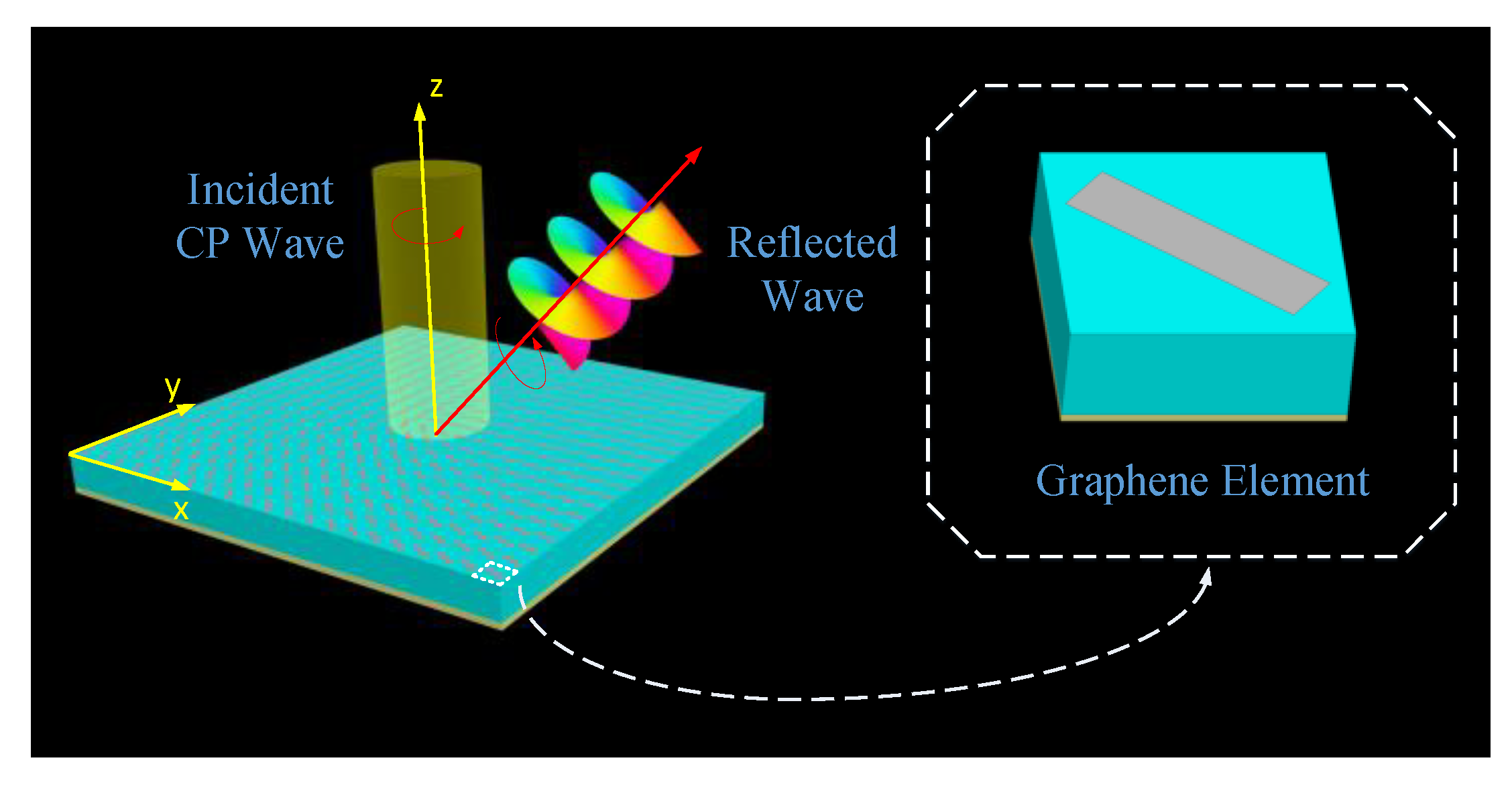
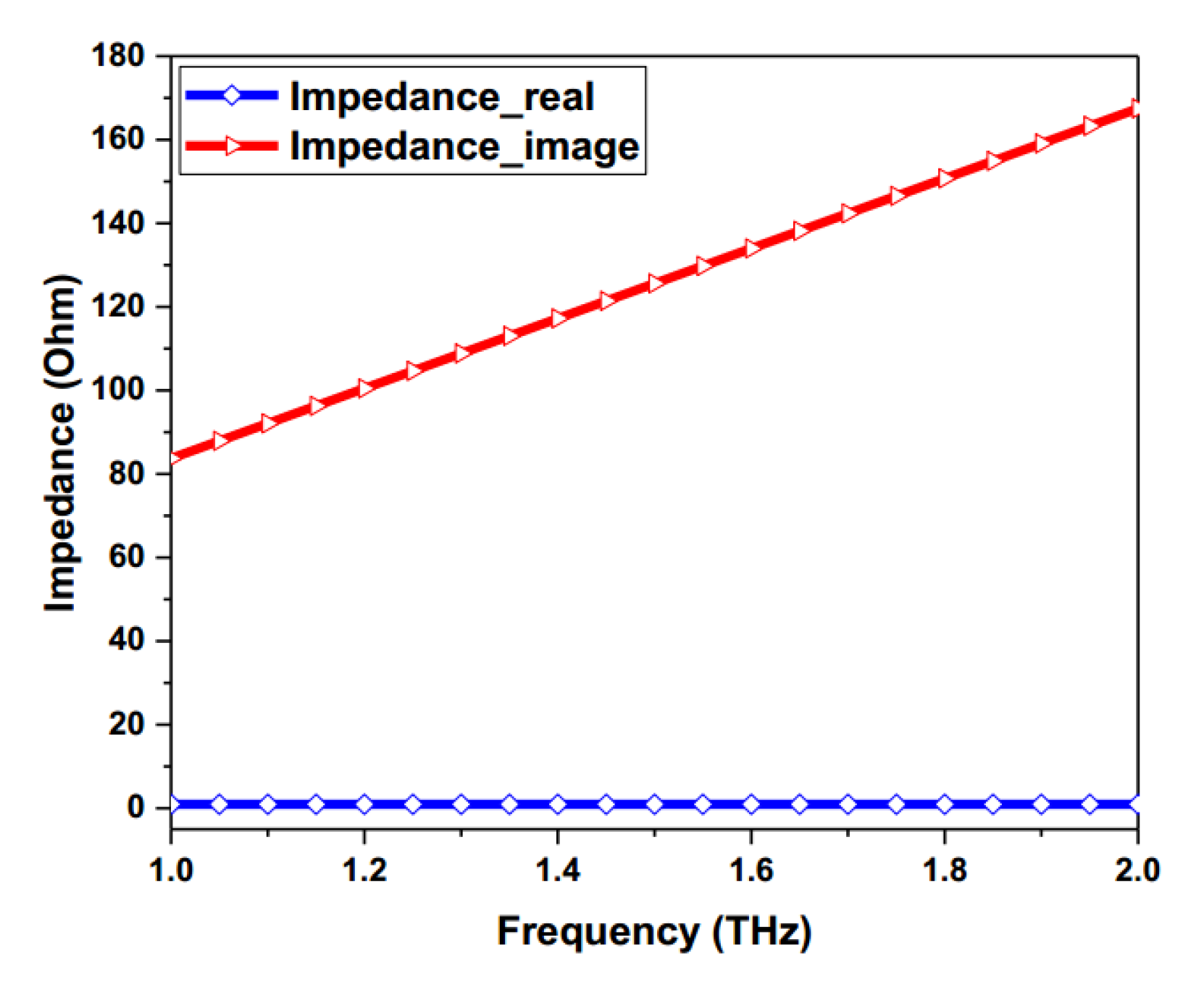
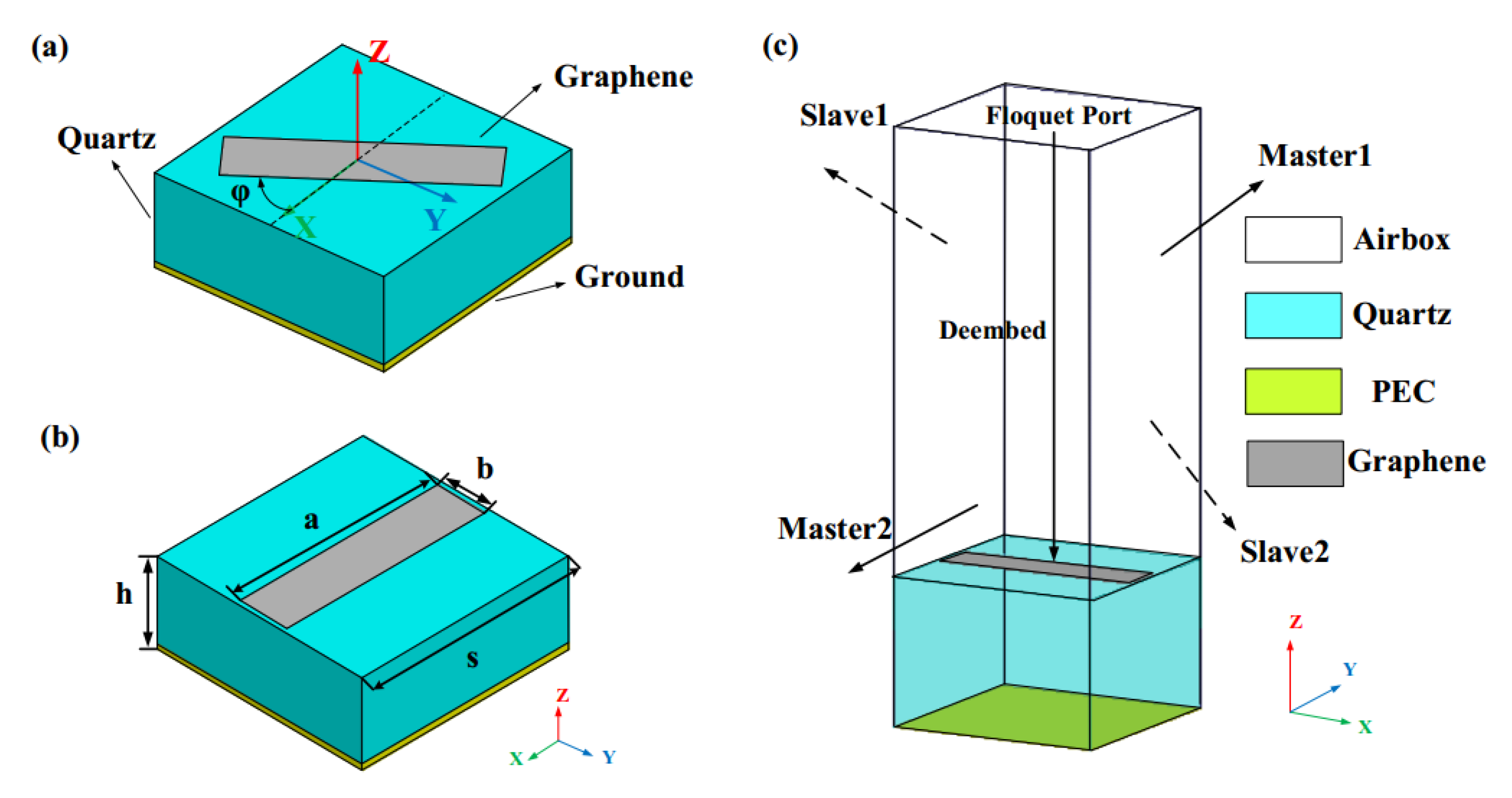

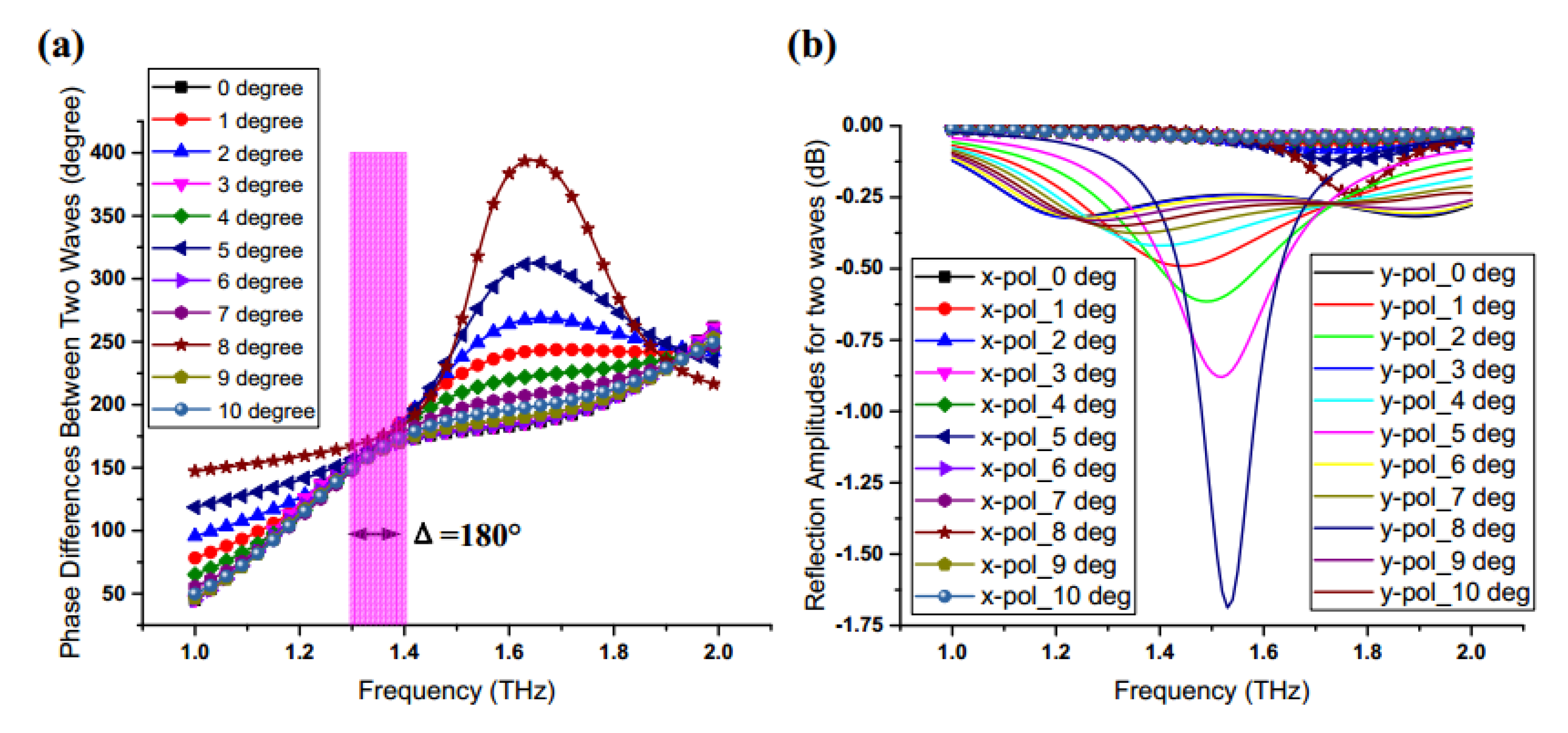

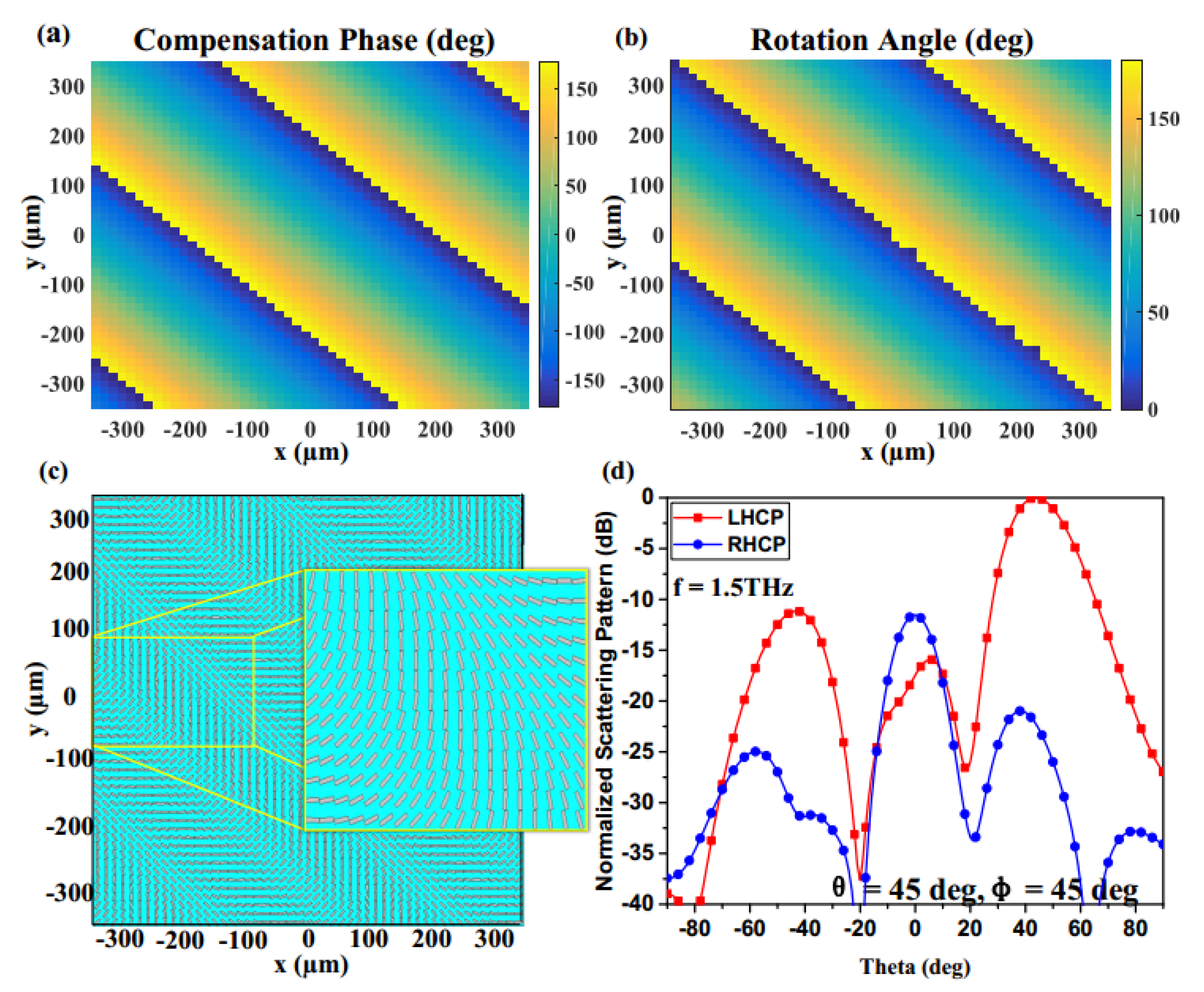


© 2018 by the authors. Licensee MDPI, Basel, Switzerland. This article is an open access article distributed under the terms and conditions of the Creative Commons Attribution (CC BY) license (http://creativecommons.org/licenses/by/4.0/).
Share and Cite
Zhang, C.; Deng, L.; Zhu, J.; Hong, W.; Wang, L.; Yang, W.; Li, S. Control of the Spin Angular Momentum and Orbital Angular Momentum of a Reflected Wave by Multifunctional Graphene Metasurfaces. Materials 2018, 11, 1054. https://doi.org/10.3390/ma11071054
Zhang C, Deng L, Zhu J, Hong W, Wang L, Yang W, Li S. Control of the Spin Angular Momentum and Orbital Angular Momentum of a Reflected Wave by Multifunctional Graphene Metasurfaces. Materials. 2018; 11(7):1054. https://doi.org/10.3390/ma11071054
Chicago/Turabian StyleZhang, Chen, Li Deng, Jianfeng Zhu, Weijun Hong, Ling Wang, Wenjie Yang, and Shufang Li. 2018. "Control of the Spin Angular Momentum and Orbital Angular Momentum of a Reflected Wave by Multifunctional Graphene Metasurfaces" Materials 11, no. 7: 1054. https://doi.org/10.3390/ma11071054
APA StyleZhang, C., Deng, L., Zhu, J., Hong, W., Wang, L., Yang, W., & Li, S. (2018). Control of the Spin Angular Momentum and Orbital Angular Momentum of a Reflected Wave by Multifunctional Graphene Metasurfaces. Materials, 11(7), 1054. https://doi.org/10.3390/ma11071054




